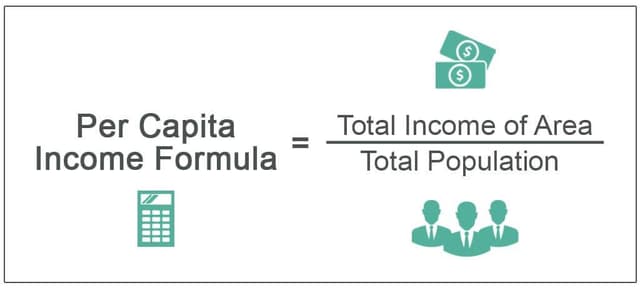Table Of Contents
Formula to Calculate Per Capita Income
Per capita income can be described as an economic barometer that measures the income earned by an individual under a given set of monetary units, such as geographic region, province, country, city, area, sector, etc. in a specified period, e.g., during a year, usually aiming to determine the average income earned by a person to evaluate the standard of living of a group of persons living under that geographical region during a specified period.
Key Takeaways
- Per capita, income is an economic measure that determines the income gained by an individual under given monetary units set like a province, geographic region, city, area, country, sector, etc., in a particular period, e.g., a year.
- Generally, per capita income aims to identify a person's average income to calculate the standard of living of a group of persons residing under that geographical region at a particular period.
- The per capita income formula comprises the total income earned by all individuals and the total population.
- The per capita income formula helps to know the area's wealth or scarcity, which allows it to make crucial socio-economic decisions.
Explanation
- Per capita income consists mainly of two parts, i.e., total income earned by all individuals and the total population. It is calculated by dividing the area's total income by the people living in that area.
- The United States Census Bureau takes the total income for last year only for people above 15 years and above and then calculates the median average of the data. It is calculated by dividing the area's total income by its population.
Examples of Per Capita Income (with Excel Template)
Let us see some simple to advanced practical examples to understand it better.
Example #1
The modern town has 100 people who earn $4,50,000 per year engaged in primary agricultural activities and 5,000 people earning $35,000 involved in manufacturing activities. Now, you are required to calculate the per capita income of a modern town.
Solution:
Per Capita Income = Total Income of Area/Total Population
The calculation of the total income of a modern town:

- = (100 * 4,50,000) + (5,000 * 35,000)
- = $4,50,00,000 + $17,50,00,000
- Total Income = $220,000,000
And, the total population will be: -

- = 100 + 5,000
- Total Population = 5,100
The calculation can be done as follows: -

- = 220,000,000/5,100

Example #2
Suppose in a city 10,000 workers work at different pay scales.

You are required to calculate the per capita income.
Solution:

- = (500 * $50,000) + (2,500 * $30,000) + (2,000 * $20,000) + (5,000 * $5,000)
- = $2,50,00,000 + $7,50,00,000 + $4,00,00,000 + $2,50,00,000
- Total Income = $16,50,00,000
The calculation of total population:

- = 500+2,500+2,000+5,000
- Total Population = 10,000

- = $16,50,00,000/10,000
The Per Capita Income will be -

Example #3
Suppose there are five companies in a city. The number of employees and the income of the companies are as follows:
Calculate the per capita income of the city.

Solution: To arrive at the per capita income of these companies, we need to perform the necessary calculations shown below.
The calculation of total income: -

- = $(25,000 + 2,00,000 + 80,000 + 50,000 +1,75,000 – 50,000 + 0)
- Total Income = $4,80,000
Now, calculate the total population: -

- = 800+500+100+200+400+500+100
- Total Population = 2,600

- = $480,000/2,600

Calculator
Relevance and Uses
- With the help of per capita income, one can get to know an area's wealth or scarcity, which helps arrive at important socio-economic decisions. We can also use it to ascertain the rank of countries or regions in ascending or descending order per their richness and wealth by knowing the average income per person.
- Additionally, per capita financial gain helps assess an area's affordability buying power. It is employed in conjunction with knowledge of land costs, for example, to verify if average homes are out of reach for the typical average family.
- It is helpful for a business person or organization to open his business or store in a particular region by using this formula for ascertaining revenue from the population of the area. The organization may decide to open/not to open a store in areas with higher per capita income compared to regions with lower ones since it helps to evaluate chances of generating more revenue by selling their goods, as more per capita income increases the spending power of the town.
- The government may make good socio-economic decisions to develop particular areas based on PCI.
Conclusion
- Per capita income is money earned per person in a specific region or geographical location.
- It is used to know the standard of living per person for a territory or geographical area population.
- As a metric has limitations, it does not consider inflation, financial gain inequality, poverty, wealth, or savings.
- Helps in making business socio-economic decisions by private/ government organizations.

